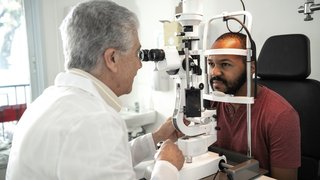Corneal refractive surgery: LASIK and beyond
December 13, 2019

When it comes to vision correction surgery, many patients immediately think of LASIK (laser-assisted in situ keratomileusis). This recognizable procedure is a type of corneal refractive surgery – a laser procedure that changes the shape of the cornea and how light reflects onto the retina, thus improving vision.
LASIK is highly effective, but not every patient is a good candidate for the procedure. However, there are a variety of corneal refractive surgeries beyond LASIK to treat a range of vision conditions such as astigmatism, nearsightedness (myopia), and farsightedness (hyperopia).
Corneal refractive surgeries have been around for more than 20 years, and advances in the last decade have resulted in less invasive, more effective procedures. Let's look at three types of refractive procedures – and a few more options – that might work to correct your vision issue.
LASIK

More than 17 million laser correction procedures have been performed since the 1990s, and data show that a majority of patients experience vision improvement. People who have a healthy ocular surface and those whose prescriptions haven't changed substantially in the previous two years may be eligible. Some systemic conditions or medications may disqualify the patient for corneal refractive procedures.
Before the Procedure
A thorough eye exam with various testing is performed to ensure the eyes are healthy enough for the refractive procedure. The refractive error, ocular surface, cornea thickness and shape, pupil size, and aberrations are evaluated to get the best outcomes.
The procedure
LASIK takes only 15 to 20 minutes. You will be given a medication to relax, then the doctor will numb your eyes with special drops. Next, the doctor will gently place an instrument around your eyes to hold the eyelids open. Then the doctor creates a thin flap in the cornea using a femtosecond laser. Femtosecond laser-assisted cornea flap creation helps the eye surgeon do his work very precisely with fewer complications. After flap creation, an excimer laser is used to reshape the cornea.
Finally, the doctor will gently lay the flap in place. No stitches are needed – the flap molds itself back to the tissue within minutes. After the procedure, your doctor might give you plastic covers for your eyes to wear the rest of the day and for a few nights as your eyes heal. You will need to avoid rubbing, bumping, or getting water in your eyes as the cornea heals.
Side effects
Fewer than 1% of patients experience surgical complications such as lasting vision problems. Most will have temporary side effects such as light sensitivity and seeing halos or glares around lights. These side effects typically go away within six to 12 months.
The Refractive Surgery Council states that up to 30% of patients experience dry eyes after surgery. Some patients may experience under-correction of vision, which often can be fixed with a second procedure. You should be able to return to work within one to two days.
Meet our team of ophthalmologists
Nationally recognized for its vision care, the UT Southwestern team of specialists is equipped to treat any type of vision problem. 'There is nothing that comes in our door that we can't handle.'
Other types of corneal refractive surgery
PRK
Photorefractive keratectomy (PRK) is a lesser-known corneal refractive surgery that treats the same vision problems as LASIK but can accommodate patients with thinner corneas. PRK uses a laser, but no flap is cut in the cornea. Instead, the epithelium, which is the thin outer layer of the cornea, is completely removed.
The epithelium grows back on its own after surgery, usually within a few days. This extra step requires a slightly longer recovery time than LASIK, though results and other side effects are comparable.
LASEK
LASEK with an "e" stands for laser epithelial keratomileusis, a variation on PRK. Whereas PRK removes and disposes of the corneal epithelium, LASEK removes and returns the epithelium to the eye. Similar to PRK, this procedure might work better for patients with thin corneas.
Results and side effects of PRK and LASEK are similar. Your ophthalmologist can help determine which procedure is right for you.
Permanent lens placement
Corneal refractive surgeries are not always possible. If you have cataracts, chronically dry eyes, thin corneal tissue, or one of several eye disorders, you may not qualify for LASIK. In this case, a permanent lens placement can help you achieve better vision and healthier eyes.

Meet Dr. Dogan, our "eye guy" at UT Southwestern Medical Center at Frisco.
Permanent lens placements involve the use of artificial lenses to either replace or work in tandem with the natural lens of the eye. No tissue is removed, making recovery shorter than corneal refractive surgeries.
Common permanent lens options include:
- Intraocular lenses (IOLs): IOLs are permanent lenses used to replace natural diseased lenses, such as in cataracts. If you experience age-related farsightedness, you may benefit from monofocal or multifocal IOLs.
- Visian ICL: Unlike IOLs, Visian lenses do not replace the eyes' natural lenses. Instead, these artificial lenses are placed between the iris and the natural lens to correct moderate to severe nearsightedness for the eyes that may not be qualified for corneal refractive procedures like LASIK or PRK.
We understand that having eye surgery is a big decision. Your ophthalmologist will work with you to create a customized plan to match your vision correction goals. Whether you choose LASIK, PRK, or a nonsurgical option, we’ll provide the information you need to feel comfortable in your decision.
To find out whether you or a loved one might benefit from corneal refractive surgery, call 469-604-9000 or request an appointment online.











